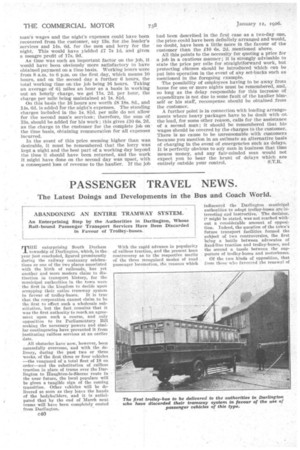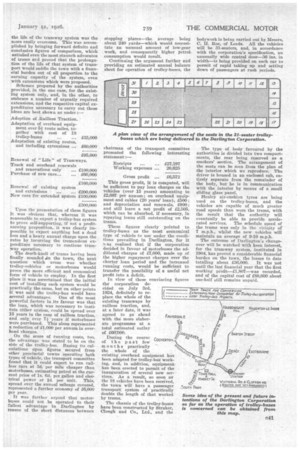PASSENGER TRAVEL NEWS.
Page 24

Page 25

If you've noticed an error in this article please click here to report it so we can fix it.
The Latest Doings and Developments in the Bus and Coach World.
ABANDONING AN ENTIRE TRAMWAY SYSTEM, An Enterprising Step by the Authorities in Darlington, Whose Rail-bound Passenger Transport Services Have Been Discarded in Favour of Trolley-buses.
TIlE enterprising South Durham _a_ township of Darlington, which, in the year just concluded, figured prominently during the railway centenary celebrations as one of the two places associated with the birth of railroads, has yet another and more modern claim to distinction in transport history, for the municipal authorities in the town were the first in the kingdom to decide upon scrapping their entire tramway system
in favour of trolley-buses. It is true that the corporation cannot claim to be the first to effect such a wholesale substitution, but the fact remains that it was the first authority to reackan agreement upon such a course, and only opposition to its Parliamentary Bill seeking the necessary powers and similar contingencies have prevented it from instituting railless services at an earlier date.
AU obstacles have now, however, been sueessfully overcome, and with the delivery, during the past two or three weeks, of the first three or four vehicles —the vanguard of a total fleet of 18 on order—and the substitution of railless traction in place of trams over the Darlington to Haughtonrle-Skerne route in the near future, the local populace will be given a tangible sign of the coming transition. Other vehicles will be delivered so soon as they leave the hands of the bodybuilders, and it is anticipated that by the end of March next trams will have been completely ousted from Darlington. With the rapid advance in popularity of railless traction, and the present keen controversy as to the respective merits of the three recognized modes of road passenger locomotion, the reasons which influenced the Darlington municipal authorities to adopt trolley-buses are interesting and instructive. The decision, it might be stated, was not reached without a considerabk amount of opposition. Indeed, the question of the towns future transport facilities formed the subject of two controversies, the first being a battle between advocates of fixed-line traction and trolley-hisses, and the second a tussle between the sup• porters of trolley-buses and motorbuses.
Of the two kinds of opposition, that from those -who favoured the renewal of
the life of the tramway system was the more easily overcome. This was accomplished by bringing forward definite and conclusive figures of comparison, which satisfied even the most staunch advocates of trams and proved that the prolongation of the life of that system of transport would saddle the town with a financial burden out of all proportion to the earning capacity of the system, even with extensions which were proposed.
Schemes prepared by the authorities provided, in the one case, for the existing system only, and, in, the other, to embrace a number of urgently required extensions, and the respective capital expenditures necessary to carry out these ideas are best shown as under:— Adoption of .Railless Traction. Adaptation of overhead equip ment over 5i route miles, to gether with cost of 18 trolley-buses 135,000 Adaptation of existing routes, and including extensions ... £60,000 £95,000 Renewal of "Life" of Tramways. Track and overhead renewals and renovations only ... £100,000 Purchase of new ears— ... £60,000 _£160,000 Renewal of existing system and extensions ... £200,000 New cars for extended system £100,000 1300,000 Upon the presentation of these figures it was obvious that, whereas it was reasonable to expect a trolley-bus system to prove self-supporting, if not a profitearning proposition, it was clearly impossible to expect anything but a dead loss and a heavy annual charge upon the rates by incurring the tremendous expenditure necessary to continue tramway operation.
The death-knell of trams having been finally sounded •án the town, the next question which arose was whether trolley-vehicles or motorbuses would prove the more efficient and economical form of vehicle to employ. In the first place it was ascertained that the initial cost of installing each system would be practically the same, but on other points It was said the trolley-bus would have several advantages. One of the most powerful factors in its favour was that the loan, which was necessary to institute either system, could be spread over 15 years in the case of railless traction, and only over 7i years if motorbuses were purchased. This alone represented a reduction of £1,000 per annum in overhead charges.
On the score of running costs, too, the advantage was stated to be on the side of the trolley-bus. Basing its calculations upon figures secured from other provincial towns operating both types of vehicle, the transport committee found that it could expect to run railless cars at 3d. per mile cheaper than motorbuses, estimating petrol at the current price of 1s. Ed. per gallon and ekc trical power at ed. per unit. This, spread over the animal mileage covered, represented a further economy of £6,000 per year.
It was further argued that motorbuses could not be operated to their fullest advantage in Darlington by reason of the short distances between stopping places—the average being about 240 yards—which would necessitate an unusual amount of low-gear work, and consequently higher petrol consumption would result.
Continuing the argument further and providing an estimated annual balance sheet for operation of trolley-buses, the chairman of the transport committee presented the following interesting statement :— Receipts ... £27,197 Working expenses 20,625 Gross profit ... £6,572 This gross profit, it is computed, will he sufficient to pay loan charges on the vehicles (over 15 years) amounting to £2,667 per annum ; on overhead equipment and cables (20 years' loan), £500; and depreciation and renewals, £900; and still leave a net profit of £2,505, which can be absorbed, if necessary, in repaying loans still outstanding on the trams.
These figures clearly pointed to trolley-buses as the most economical type of vehicle to use under the conditions prevailing in Darlington, for it I. as realized that if the corporation decided in favour of motorbuses the additional charges of £7,000, made up of the higher repayment charges over the shorter loan period and the increased running costs, would be sufficient to transfer the possibility of a useful net profit into a deficit.
In view of these convincing figures the corporation decided on July 3rd, 1924, definitely to replace the whole of the existing tramways by railless traction, and, at a later date, it was agreed to go ahead with the more elaborate programme at a total estimated outlay of £607000.
During the course of the past few months practically the whole of the existing overhead, equipment has been adapted for trolley-bus working, and, in addition, equipment has been erected to permit of the inauguration of several new services. As a result, so soon as the 18 vehicles have been received, the town will have a passenger transport system of practically double the length of that worked by trains.
The chassis of the trolley-buses have been constructed by Straker, Clough and Co., Ltd., and the
COCKERTON 44'
bodywork is being carried out by Messrs. C. H. Roe, of Leeds. All the vehicles will be 31-seaters, and, in accordance with the corporation's specification, an unusually wide central door-36 ins, in width—ix being provided on each car to permit of rapid taking up and setting down of passengers at rush periods.
The type of body favoured by the authorities is divided into two compartments, the rear being reserved as a smokers' section. The arrangement of the seats can be seen from the plan of the interior which we reproduce. The driver is housed in an enclosed cab, entirely separate from the remainder of the body, but he is in communication with the interior by means of a small sliding glass panel.
Henley air-cushion tyres are being used on the trolley-buses, and the vehicles are capable of much greater road speeds than were the trams, with the result that the authority will eventually be able to provide accelerated services. The schedule speed of the trams was only in the vicinity of 7 m.p.h., whilst the new vehicles will maintain an average of 9-10 m.p.h.
The outcome of Darlington's changeover will be watched with keen interest, for the tramway system, instituted in 1991, has proved a considerable financial burden on the town, the losses to date totalling about £36,000. It was not until the last financial year that the first working profit—£1.807—was recorded, and of the capital cost of £80,000 about one-half still remains unpaid.
































